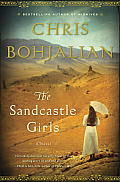
When I was five years old, I was so fat that my mother bought all my pants at a store called "The Husky Boys' Shop," and still my pants were cuffed almost to my knees. She would dress me up in red velvet knickers and a white turtleneck shirt, and then parade me before her in-laws ? as well as assorted aunts and uncles and cousins ? to sing "I'm Henry the VIII, I Am." The song, a 1965 Herman's Hermits hit, is a bauble that somehow manages to be at once utterly forgettable and weirdly memorable. ("Everyone was an En-er-e! En-er-e!")
Yup. A fat kid in red velvet knickers singing Herman's Hermits with a bad British accent. How is it that no one ever beat me up?
But here is the most interesting part of the memory. My mother was Swedish. My father was Armenian. And where precisely was I singing "I'm Henry the VIII, I Am"? In my Armenian grandparents' living room, in a home so exotic by the standards of a New York City suburb in the 1960s that my mother christened the house "the Ottoman Annex of the Metropolitan Museum." There were plush Oriental carpets, my grandmother's intricate Armenian lace doilies, and thick leather books filled with an alphabet I couldn't begin to decipher. And there was, invariably, the enticing aroma of cooked lamb and mint. My grandfather insisted on a lamb chop even for breakfast.
It was a small world that was foreign ? but also a little magic. My mother adored her in-laws and my Armenian grandparents adored her. Sure, she was an odar ? an outsider ? but that distinction no longer mattered by the time I was born.
When I was writing the opening pages of my new novel, The Sandcastle Girls, a love story set in the midst of the Armenian Genocide in the First World War, I began with my memories of those weekends when I would sing in my knickers. I knew soon enough the book was going to have lengthy sections of deeply painful material and I wanted to ease myself ? and readers ? into those horrors. After all, this was a book about the death of one and a half million people, many in the unforgiving sands of the Syrian Desert. Three out of every four Armenians living in the Ottoman Empire in 1915 would be dead before the First World War was over, and my family's history paralleled the massacre too perfectly: Three of my four Armenian great-grandparents perished.
Moreover, unless you are Armenian or part-Armenian, chances are you're only dimly aware of the nightmare. As early as 1939, less than a quarter century after the Genocide, Adolf Hitler ordered his commanders to be "merciless" in Poland, remarking, "Who, after all, speaks today of the annihilation of the Armenians?"
As an Armenian-American and the grandson of survivors, this was going to be a deeply personal story ? in some ways, the most personal story I had ever written. (When I was at the Genocide Memorial in Yerevan recently or standing before the bones from Der-el-Zor in the Genocide Chapel in Beirut, all I had to do was glance at the old family photos on my iPhone to know why this book mattered so much to me.)
Consequently, I decided to begin with family history ? with a moment that would allow me to walk slowly from the light of the present into the shadows of the past. I created a female version of myself: an Armenian-American novelist at mid-life named Laura Petrosian, who has thought far too little about her ancestry and why she is who she is. Her childhood was, in some ways, a reflection of mine with merely the gender pronouns reversed. To wit, her first boyfriend in Miami, Florida, was Turkish, just as my first girlfriend was.
Her grandparents in the novel are not my grandparents, but I hope their fictional experiences are compelling drama and illuminate what my narrator christens "The Slaughter You Know Next to Nothing About."
The result is a book that moves back and forth in time, between Laura's present and her grandparents' past. The structure allows readers to catch their breath. Me, too. We can all escape for a little while from the searing desert sun; we can reflect on the crime that historian Raphael Lemkin christened "genocide;" and, yes, we can watch a child ? in this case, Laura's brother ? grow up and out of a pair of red velvet knickers.
The Sandcastle Girls was published this month by Doubleday Books. It's Chris's 14th novel. You can visit him at
Chrisbohjalian.com, or follow him on Facebook and Twitter.